A 3-Step Guide to Rolling from 500 to 50,000 Units: Leveraging Small Capital to Boost It (with Position Management Formula)
I have practiced this method for tens of thousands of transactions, with a winning rate of up to 98%! Last month in March, I also earned 120,000 U in just one month!
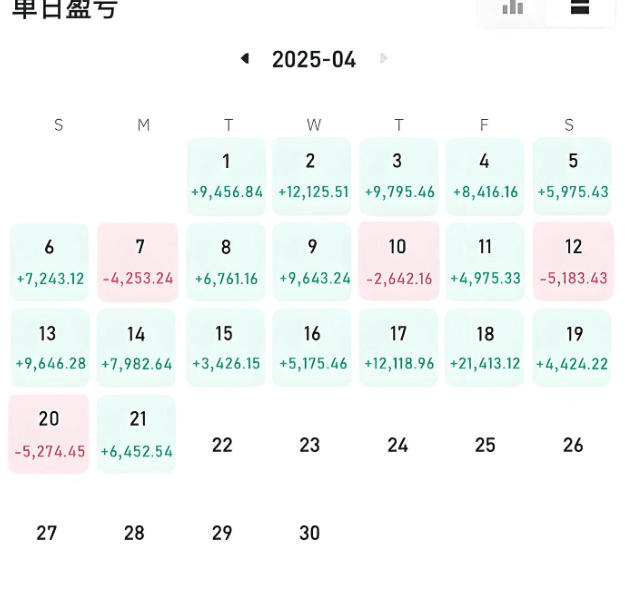
1. Startup Period (500U→2000U): Use "10% Position + 10x Leverage" to Take Advantage of the First Boom of New Coins
Core Logic: Only use 50U (10% of the principal) for trial and error each time, and lock the single loss within 5U (stop loss 10%)
50U x 10x leverage = 500U position, target 20% increase (earn 100U)
In August 2025, HTX will be launched on BOT. With a leverage of 10x for 50U, buy the dip when the price drops 15%, and then increase 30% in 3 hours, earning 150U. Roll the position to 650U, and repeat 8 times to 2100U.
Avoid emotional operations
Explosive Period (2000U→10,000U): Switch to "20% Position + 5x Leverage" to Chase the Big Whales
The DeFi2.0 leader FLX was launched in September 2025. 400U principal with 5x leverage (2000U position), stop loss 5% (loss 20U), target 15% (earn 60U), 3 days of increase of 40%, direct profit of 1600U, rolling position to 3700U
Immediately move the stop loss to the cost line after making a profit of 10% to ensure that the principal is not lost
III. Final Stage (10,000 U → 50,000 U): "Hedging + Step-by-Step Rollover" to Prevent Black Swan Events
After each profit, 30% is withdrawn and deposited into BTC spot, and 70% is used to open a new position according to the "half-position method"
Steps
1. After 10,000 U is received, use 3,000 U to buy BTC (anti-fall anchor)
2. Split 7000U into 7 orders, each with 1000U to open an ETH perpetual swap (2x leverage = 2000U position)
3. Set a 3% stop loss (30U loss) and a 5% take profit (50U profit) for each order. If 4 out of 7 orders are profitable, you can exceed 20,000 U.
Fatal detail: When the total asset drawdown exceeds 15% (e.g., from 30,000 to 25,500), immediately close 60% of the position and trigger the "20% profit protection line" before restarting
Trap 1: Go all-in on a new coin (someone once invested 300U in MEME coins, only to be liquidated within an hour and owe 200U)
Trap 2: (Not taking a stop-loss when the price drops 15%, but instead increasing the position, ultimately losing the principal)
Trap 3: Run away after making a small profit (earn 1500U from 1000U and withdraw 1200U, missing out on the subsequent 10x increase)
3 iron laws:
1. Use 500U as 50U: Open a position at a time not exceeding 10% of the principal, reducing the "zero risk" to less than 0.5%.
2. Only invest when BTC stabilizes at 68,000 U: When the market stabilizes, the probability of hot coins exploding increases by 3 times
3. Profit = Position × Odds × Discipline: The first two determine your upper limit, while the last determines whether you can survive to reach "50,000 U".
In the cryptocurrency world, 500U is not the principal, but the ticket to "leverage with discipline"
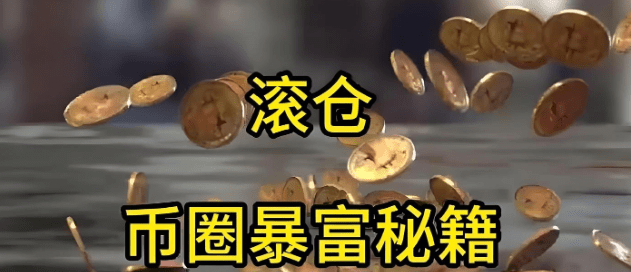
Super Crypto Trading Method: Rolling Over 300 Times in 3 Months, Easily Earning 30 Million
Since the Federal Reserve cut interest rates, many newcomers have flocked to the cryptocurrency market. The cryptocurrency world is a place where only the fittest survive. The low barrier to entry means anyone can enter, but not everyone can make money. If you're considering entering the cryptocurrency world, remember that it's not a get-rich-quick scheme; it's a field that requires long-term accumulation and continuous learning.
Many people enter the cryptocurrency world with the dream of getting rich overnight, fantasizing about turning a few thousand yuan into a million yuan. While some have succeeded, in most cases, this is achieved through "rolling." While rolling is theoretically feasible, it's by no means an easy path.
Rolling is a strategy designed to be used only when big opportunities arise, not frequently. Seizing a few such opportunities in a lifetime can build a fortune from zero to tens of millions. Tens of millions in assets are enough to elevate an average person to the ranks of the wealthy and achieve financial freedom.
When you truly want to make money, forget about how much you want to earn or how you'll achieve it, and forget about those tens of millions or even hundreds of millions of yuan goals. Instead, focus on your own practical situation and give yourself more time to settle in. Boasting won't bring about substantial change. The key to trading lies in identifying the size of opportunities. You can't always hold a light position, nor a heavy one. Practice with small amounts in normal times, and when the big opportunity presents, go all in. By the time you've truly made your fortune from a few tens of thousands of yuan to one million yuan, you'll have unknowingly learned the principles and logic of making big money. At this point, your mindset will become more stable, and future trades will be more like repeating past successes.
If you want to learn how to roll over, or if you want to learn how to make millions from a few thousand, then you should read the following content carefully.
1. Determine the timing of rolling positions
Rolling a position isn't something you can do whenever you want. It requires certain background and conditions to have a good chance of success. The following four situations are most suitable for rolling a position:
(1) Breakout after a long period of sideways movement: When the market has been sideways for a long time and volatility has dropped to a new low, once the market chooses a breakthrough direction, you can consider using rolling positions.
(2) Buying the bottom during a big drop in a bull market: In a bull market, if the market experiences a round of sharp rise and then suddenly drops sharply, you can consider using rolling operations to buy the bottom.
(3) Weekly level breakthrough: When the market breaks through a major weekly resistance or support level, you can consider using rolling positions to seize the breakthrough opportunity.
(4) Market sentiment and news events: When market sentiment is generally optimistic or pessimistic, and there are major news events or policy changes that may affect the market in the near future, you can consider using rolling positions.
Only in the four situations mentioned above will a rolling position have a high chance of success. Otherwise, you should proceed with caution or forgo the opportunity. However, if the market appears suitable for rolling, you still need to strictly control risk and set stop-loss points to prevent potential losses.
2. Technical Analysis
Once you've confirmed that the market meets the conditions for rolling positions, the next step is technical analysis. First, confirm the trend by using technical indicators like moving averages, MACD, and RSI to determine direction. If possible, combine multiple indicators to confirm the trend direction; after all, it's always a good idea to be prepared. Secondly, identify key support and resistance levels to determine the validity of a breakout. Finally, use divergence signals to capture reversal opportunities. (Divergence signals: When a currency's price reaches a new high but the MACD doesn't, forming a top divergence, signals a price rebound and encourages reducing positions or going short. Similarly, when the price reaches a new low but the MACD doesn't, forming a bottom divergence, signals a price rebound and encourages increasing positions or going long.)
3. Position Management
After this step is completed, the next step is position management. Reasonable position management includes three key steps: determining the initial position, setting the rules for increasing the position, and formulating a strategy for reducing the position. Let me give you an example to help you understand the specific operations of these three steps:
Initial position: If my total capital is 1 million yuan, then the initial position should not exceed 10%, that is, 100,000 yuan.
Rules for adding positions: You must wait until the price breaks through the key resistance level before adding positions. Each increase in position should not exceed 50% of the original position, that is, a maximum of 50,000 yuan can be added.
Scaling strategy: Gradually reduce your position after the price reaches your expected profit target. Don't hesitate when it's time to let go. Reduce your position by no more than 30% at a time to gradually lock in profits.
In fact, as ordinary people, we should charge more when the opportunities are great, and charge less when the opportunities are few. If we are lucky, we can make millions, and if we are unlucky, we can only accept it. But I still want to remind you that when you make money, you should withdraw the invested capital, and then use the earned part to play. You can not make money, but you cannot lose money.
4. Adjusting Positions
After completing position management, the most critical step is how to implement rolling position operations through position adjustments.
The operation steps are undoubtedly those steps:
1. Choose the right time: Enter the market when the market meets the conditions for rolling positions.
2. Open a position: Open a position based on technical analysis signals and choose a suitable entry point.
3. Increase positions: Gradually increase positions as the market continues to develop in a favorable direction.
4. Reduce positions: Gradually reduce positions when the predetermined profit target is reached or the market shows reverse signals.
5. Close the position: When the profit target is reached or the market shows a clear reversal signal, close the position completely
Here I will share with you my specific operation of rolling position:
(1) Adding to floating profits: When an investment asset appreciates in value, you can consider adding to your position, but only after ensuring that your holding costs have been reduced to mitigate the risk of losses. This doesn't mean you should add to your position every time you make a profit, but rather, you should do so at the right time. For example, you can add to your position during a convergence breakout within a trend, then quickly reduce your position after the breakout. You can also add to your position during a trend pullback.
(2) Base position + T-trading: Divide the assets into two parts, one part remains unchanged as the base position, and the other part is used to buy and sell when the market price fluctuates to reduce costs and increase returns. The proportions can be referred to the following three types:
1. Half-position rolling: half of the funds are used for long-term holding, and the other half is used for buying and selling when prices fluctuate.
2. 30% base position: 30% of the funds are held for the long term, and the remaining 70% is used to buy and sell when prices fluctuate.
3. 70% base position: 70% of the funds are held for the long term, and the remaining 30% is used to buy and sell when prices fluctuate.
The purpose of doing this is to optimize holding costs while maintaining a certain position and taking advantage of short-term market fluctuations.
V. Risk Management
Risk management primarily consists of two parts: overall position control and capital allocation. Ensure that your overall position does not exceed your risk tolerance. Be rational when allocating funds, and avoid investing all your capital in a single transaction. Of course, you also need to monitor your position in real time, closely monitoring market trends and technical indicators. Adjust accordingly, using stop-loss orders or adjusting positions when necessary.
Many people are both intimidated and eager to try the idea of rolling positions, wanting to try it but fearing the high risk. In reality, rolling positions are not inherently risky; the risk comes from leverage, but when used appropriately, it's not a significant risk.
For example, if I have 10,000 yuan in capital and open a position when a certain coin is trading at 1,000 yuan, I use 10x leverage and only use 10% of my total capital (1,000 yuan) as margin. This is effectively equivalent to 1x leverage. If I set a 2% stop-loss, if it's triggered, I'll only lose 2% of that 1,000 yuan, or 200 yuan. Even if my position is ultimately liquidated, I'll only lose that 1,000 yuan, not my entire capital. People who get liquidated often use higher leverage or larger positions, which can trigger a liquidation even with the slightest market fluctuation. However, using this method limits your losses even if the market moves against you. So, you can roll over at 20x, 30x, 3x, or even 0.5x. Any leverage is fine; the key is to use it appropriately and manage your position size appropriately.
The above is the basic process of using a rolling position. Those who want to learn can read it several times and carefully consider it. Of course, there will be different opinions, but I only share my experience, not to convince others.
So how can you make a small amount of money bigger?
The effect of compound interest is crucial here. Imagine you own a coin, and its value doubles every day. After a month, its value will be staggering. Doubled on the first day, doubled again on the second, and so on, the final value will be astronomical. This is the power of compound interest. Even if you start with a small amount of money, after repeated doubling over time, it can grow to tens of millions.
For those who are considering a small investment, I recommend focusing on larger goals. Many people believe that small capital should be used for frequent short-term trading to achieve rapid growth, but this is actually more suited to medium- and long-term investment strategies. Rather than aiming for small daily profits, focus on achieving multiples of profit with each trade, using the unit of measure being exponential growth.
When it comes to position management, the first thing to do is to diversify your risk and avoid concentrating all your funds on a single trade. Divide your funds into three or four parts, and trade only one part at a time. For example, if you have 40,000 yuan, divide it into four parts, and trade with 10,000 yuan. Secondly, use leverage appropriately. My personal recommendation is to avoid using more than 10x leverage for big and small stocks, and less than 4x leverage for small and medium-sized stocks. Furthermore, you should adjust your leverage dynamically. If you lose money, replenish it with an equal amount from external sources. If you gain money, withdraw it appropriately. In any case, you should avoid losing money. Finally, increase your position, of course, only if you are already profitable. Once your funds grow to a certain level, you can gradually increase the amount of each trade, but avoid adding too much at once; build in a gradual process.
I believe that through proper position management and a sound trading strategy, even a small amount of capital can achieve significant growth over time. The key lies in patiently waiting for the right opportunity and focusing on the larger goal of each trade, rather than small daily profits. Of course, I've experienced margin calls, but the gains from spot trading offset those losses. I doubt you'll ever earn nothing from your spot trading. My futures portfolio only accounts for 2% of my total capital, so no matter how much I lose, I won't lose it all, and the amount of losses is always within my control. Ultimately, I hope each of us can build on our accumulated experience and achieve millions of dollars.

The most stable way to play cryptocurrency contracts
Choose the right coins and be a good person. As a leveraged trader, volatility can be amplified by leverage. The primary consideration during trading is not volatility, but certainty. Go long on strong coins in rising markets, and conversely, go short on the weakest coins in falling markets. For example, at the beginning of a new quarter, EOS and ETH saw the strongest gains, making them the top picks for long positions. During a decline, Bitcoin was the top pick for shorting. Even if mainstream coins ultimately fall more than Bitcoin, shorting or chasing Bitcoin exclusively can greatly reduce the risk of a violent pullback. Most traders in the cryptocurrency market are short-term traders. They rarely have the opportunity to close their positions at their ideal price. They are also not proficient in position control and cannot rely on price fluctuations to manipulate the market. Given this, a good entry price is paramount for most traders. Once a profit is made, sell a portion to lock in the profit, and set a stop-loss at the cost price for the remaining portion. This is something I consistently emphasize in my community. The essence of a contract trading strategy: (1) Identify the primary trend and enter the market following it; otherwise, avoid entering the market. (2) If you are trading with the trend, the entry points are: 1. A new breakthrough point in the trend; 2. A breakthrough point when the sideways trend moves in a certain direction; 3. A pullback point in an upward trend or a rebound point in a downward trend.
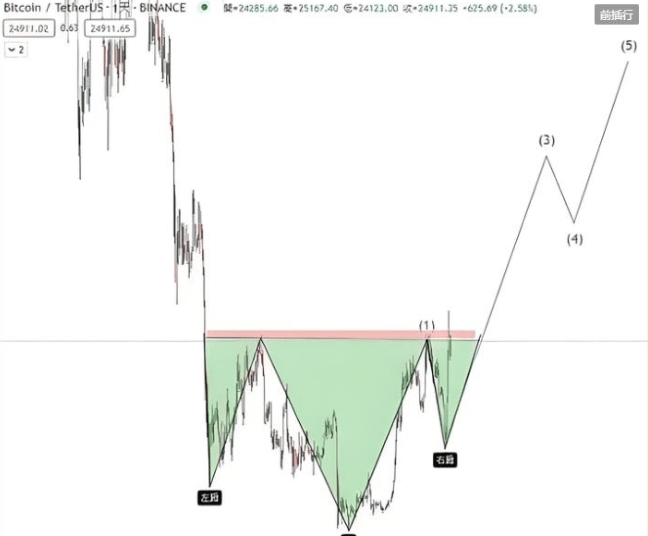
(3) Positions that follow the trend will bring you lucrative profits, so don't exit prematurely. (4) If your position is in line with the broader trend and your book profits have proven you're right, you can use the pyramiding technique to increase your position (see reference 2). (5) Hold your position until the trend reverses and you close your position. (6) If the market trend goes against your position, stop your losses and run. In addition to adhering to the above strategies, remember three key qualities: discipline, discipline, and discipline! The key to trading is accumulating small gains, and compound interest is king. If you've lost your investment, you must never let it fall back into losses. If you've made a profit, be sure to lock in a portion to avoid wasting your time. In short: sell when you're profitable, and avoid losses at the original price.
I am the Chief Instructor. I have experienced many bull and bear cycles and have rich market experience in various financial fields. Follow the official account (Bit Chief Instructor) and here, you can penetrate the fog of information and discover the real market. Seize more opportunities for wealth codes and discover truly valuable opportunities. Don't miss out and regret it!
Tips for making money with perpetual contracts
1. Avoid going all-in. How should funds be allocated? Fund allocation should be understood from two perspectives: First, from a risk perspective. First, determine the amount of loss your account can or is prepared to withstand. This forms the foundation of your fund allocation. Once this total amount is determined, consider how many times, if we repeatedly lose in the market, we should willingly admit defeat. Personally, I believe the riskiest approach should be three times. In other words, you should give yourself at least three chances. For example, if your account balance is 200,000 yuan and your client allows you to lose a maximum of 20%, or 40,000 yuan, then your riskiest loss scenario is: 10,000 yuan the first time, 10,000 yuan the second time, and 20,000 yuan the third time. I believe this loss scenario has some rationality. If you get it right once out of three times, you can profit, or even survive in the market. Not getting eliminated by the market itself is a success, a chance to win.
2. Grasp the overall market trend. Trend trading is far more difficult than volatility trading because it's about chasing ups and selling downs, requiring perseverance and holding positions. Buying low and selling high is perfectly in line with human nature. The more human nature is in trading, the less profitable it is. It's precisely because it's difficult that it's profitable. In an upward trend, any sharp pullback should prompt a long position. Remember what I said about probability? So, if you're not on the train, or have gotten off, wait patiently. If there's a 10-20% drop, then go long.
3. Specifying Stop-Loss and Take-Profit Targets. Stop-loss and take-profit targets are crucial for profitability. Across multiple trades, we need to ensure that our total profits exceed our total losses. This is actually quite simple to achieve. Simply adhere to the following: ① Each stop-loss is ≤ 5% of your total capital; ② Each profit is > 5% of your total capital; ③ Your total trading win rate is > 50%. Meeting these requirements (profit-loss ratio greater than 1 and win rate greater than 50%) will result in profitability. Of course, you can also achieve a higher profit-loss ratio with a lower win rate, or vice versa. As long as your total profit remains positive, you'll be fine: total profit = initial stake × (average profit × win rate - average loss × loss rate).
4. Beware of excessive trading. Because BTC perpetual contracts trade 24/7, many novices trade daily, wishing they could trade every day of the 22 trading days in a month. As the saying goes, "If you walk by the river, you'll get your feet wet." Frequent trading leads to mistakes, which can lead to a negative mindset. Once a negative mindset develops, you may act impulsively, opting for "retaliatory" trades: perhaps going against the trend or increasing your position. This can lead to numerous missteps, easily resulting in significant losses on paper, which can take years to recover.
5. Contract Entry Timing: Many users open contracts 24/7, which is practically the same as giving away money. The purpose of contracts is to develop a stable profit strategy within controllable risks and relatively stable indicators, not to click buy and get rich quick! Therefore, contract entry timing is extremely important!
⑴: Do not open orders during periods of significant good or bad news, because the market is very chaotic at this time, and the spot price can fluctuate rapidly between 1-3%. If you choose to gamble on the market at this time, you will easily be carried away by the Tiandizhen.
(2) I generally enter the market after a significant fluctuation, after the second bottom or rise, because after the second wave, the market volatility gradually stabilizes. The risk factor in the subsequent period is the lowest. The purpose of contracts is to implement the most appropriate strategy within the minimum risk range.
⑶: Enter the market within the indicator range, and never place a trade unless the indicator parameters meet your expectations. This can be understood as entering the market within your strategy and ignoring market trends until they reach your target price. Because leverage increases with contracts, risk also increases, so self-discipline is crucial. Simply put, only trades can be placed when the market stabilizes and the indicators are in place, and the risk factor has been reduced by 50%. Perpetual Futures Cons: Liquidation Risk: Liquidation occurs when a position's losses reach a certain level, resulting in insufficient margin to support the position. This occurs when the exchange automatically forces a liquidation to protect the interests of the exchange and other traders. As we mentioned earlier, the underlying logic of futures trading is leveraged lending. For example, Xiaoyu has a 100 USDT investment capital and uses 10x leverage to open a 1,000 USDT long BTC position. If the Bitcoin price is currently 100 USDT, this position essentially means borrowing 900 USDT and using the principal to purchase 10 BTC, hoping to profit when the price rises and sell them. However, if the Bitcoin price drops to 90 USDT per coin, the 10 BTC held will only be worth 900 USDT at market price, which is exactly the amount Xiaoyu borrowed. If the price continues to fall, the value of these 10 BTC will fall below the amount Xiaoyu borrowed. Since exchanges are determined not to allow themselves to suffer losses, they will liquidate Xiaoyu's position when the Bitcoin price drops 10%, or to 90 USDT per coin. This is known as a "margin call." After a margin call, not only does the user not profit, but they also lose the margin (principal) they used to open the position. Furthermore, the higher the leverage used, the more likely you are to experience a margin call. In the above example, with 10x leverage, a 10% price fluctuation in the opposite direction would result in a margin call; with 100x leverage, a 1% price fluctuation in the opposite direction would result in a margin call. The above example assumes a 100% loss before a margin call occurs. However, in actual trading, each exchange calculates the margin call loss percentage differently, with some using a 90% percentage. Therefore, in specific transactions, it is more accurate to directly refer to the exchange's liquidation price. A market spike is a sudden, violent market fluctuation followed by a rapid return to normal.This situation could trigger stop-loss orders or cause margin calls, leading to losses for investors. A spike in liquidity could be due to insufficient exchange liquidity or malicious market manipulation. Funding Fee Erosion As mentioned earlier, exchanges now require users holding perpetual contract positions to pay a funding fee every 8 hours. While it's only 0.000x%, if the position is large and held for a long time, the cumulative effect of each funding fee can be significant.
Contracts are risky, so trade with caution! Combined with the MACD indicator, your winning rate can reach 70%, helping you avoid margin calls!
To put it bluntly, playing in the cryptocurrency world is a battle between retail investors and bankers. If you don't have cutting-edge news and first-hand information, you can only be slaughtered! If you want to plan together and harvest the bankers together, you can come to (Official Account: Crypto Chief Instructor) Welcome like-minded people in the cryptocurrency world to discuss together~ Contract MACD combat tips:
1. MACD is above the zero axis. Every time a golden cross occurs, the price of the currency is about to reach a new high.
2. MACD is below the zero axis. Every time a death cross occurs, the price of the currency is about to hit a new low.
3. MACD forms a golden cross below the zero axis, which indicates a downward trend rebound. It will not participate until it reaches the zero axis.
4. MACD crosses above the zero axis, indicating an upward bullish trend. Buy low and sell high until the top diverges. If MACD is low, the price will rise, but the next wave of red bars will not be as high as the previous wave, indicating a decline.
5. If MACD is small, the price of the currency will fall or remain flat, and the next wave of green bars will not be as low as the previous wave, which means it will rise.
6. MACD shrinks at a high level: After the currency price rises sharply, MACD moves away from the zero axis and the red column shortens, moving away quickly.
7. MACD golden cross at a low level: After the currency price drops sharply, MACD moves away from the zero axis and is bound to rise. A second golden cross will increase the rise even more violently.
8. MACD golden pit: the currency price rises and then falls back. MACD dead crosses within 7 days, the green column is short and there is a golden cross, which means it is rising.
The MACD indicator plays a very special role in technical analysis and can be said to be an essential part of learning technical analysis. Its importance lies in at least the following points.
1. The MACD indicator is the most effective technical indicator that has been tested by historical trends and is also the most widely used indicator.
2. The MACD indicator is derived from the EMA indicator and is very effective in identifying market trends. Trend investors generally refer to this indicator in their actual trading.
3. The top and bottom divergence of the MACD indicator is the recognized and best-used method of "picking the bottom and selling the top". This method is an important tool for the concretization of trend theory and wave theory.
4. Many veteran traders have this experience: they start to learn the MACD indicator when they first get started, then gradually abandon it, and after a long period of study and comparison, especially after actual combat testing, they finally return to the MACD indicator. This shows the special features of this indicator.
5. The MACD indicator is also widely used in quantitative trading. Precisely because of these advantages, it has become the most commonly used technical indicator by professional traders. The concept and algorithm of the MACD indicator: The MACD indicator, also known as the Moving Average Convergence Divergence (MACD), was created by Geral Apple as a technical analysis tool used to track price trends and identify trading opportunities based on candlestick patterns. This indicator is commonly used in market analysis software and is known as the "King of Indicators," as shown in Figure 1.
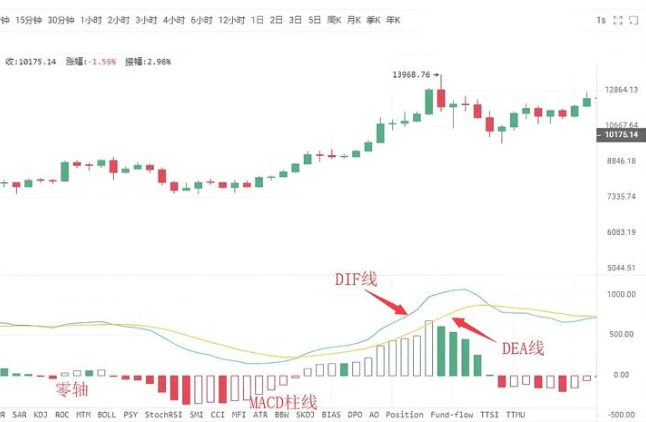
The cryptocurrency MACD indicator consists of three lines and one axis: the DIF fast line, the DEA slow line, the MACD-bar chart, and the zero axis. Investors analyze prices based on crossovers, divergences, breakouts, and support and resistance patterns of these three lines and one axis. The MACD indicator is listed as a preferred indicator in many market analysis software, demonstrating its widespread application and its historically proven effectiveness and practicality. The MACD Golden Cross and Death Cross patterns are crucial in technical analysis. A Golden Cross, also known as a golden cross, occurs when a relatively short-term indicator line crosses upward and crosses over a relatively long-term indicator line (of the same type), often signaling a short-term buying opportunity. If a Golden Cross pattern appears after: 1. a short-term, rapid decline during a downtrend; 2. a pullback during an uptrend; or 3. a consolidation during an uptrend, that is, at a specific low point during an uptrend, it is a more reliable buy signal. A death cross, also known as a death cross, occurs when a relatively short-term indicator line crosses downward and crosses over a relatively long-term indicator line (of the same type). This often signals a short-term sell opportunity. If a death cross occurs after ① a period of consolidation during a decline; ② a rebound during an uptrend; or ③ a short-term rapid rise during an uptrend, that is, when a death cross occurs at a specific high point, it is a more reliable sell signal. After understanding the golden cross and death cross patterns, we can take a closer look at the golden cross and death cross patterns of the MACD indicator line. Golden crosses and death crosses appearing in different locations reflect different market implications. Situation 1: Buying Points at Low-Level Golden Crosses If the DIFF and DEA lines form a golden cross below and far from the zero axis, this is called a low-level golden cross. Investors can view this golden cross as merely a short-term price rebound. Whether the K-line can form a true reversal requires observation and confirmation in conjunction with other indicators.
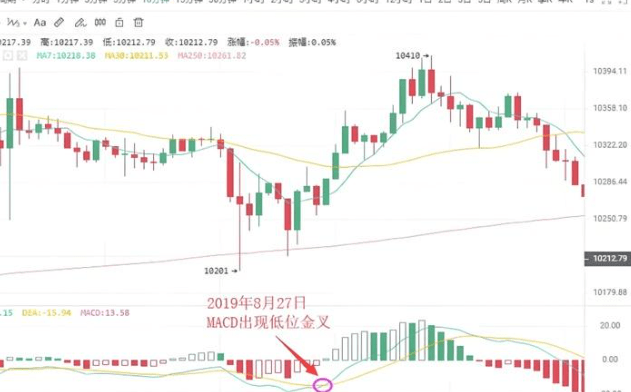
As shown above: On August 27, 2019, the 10-minute BTC candlestick chart showed a low-level golden cross as the price corrected, followed by a $200 rebound. Short-term investors can seize this opportunity to enter the market. Situation 2: Buying point near the zero-axis golden cross. If an uptrend has already formed and the DIFF and DEA lines form a golden cross near the zero axis, this is often an excellent time for investors to buy. This is because, after the uptrend is established, a golden cross near the zero axis indicates that the correction has completely ended and a new round of upward movement has begun. If this is accompanied by a golden cross of the average volume line, it means that the price increase is supported by trading volume, and the buy signal will be more reliable. Once this buying point appears, investors must not miss it, otherwise they will miss out on the big rally.
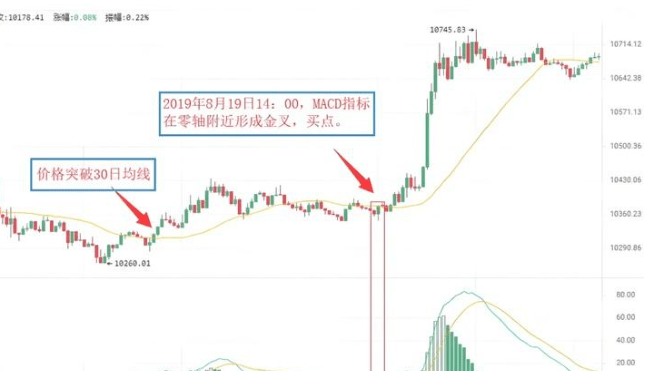
As shown in the figure above: At 09:30 on August 19, 2019, the BTC 5-minute candlestick chart shows that Bitcoin broke through the 30-day moving average, indicating that an upward trend has initially formed. For a period of time thereafter, the price has almost always been running above the 30-day moving average. At 14:00 on August 19, 2019, the MACD indicator formed a golden cross near the zero axis, indicating that the market is about to see a large upward trend. Investors can buy decisively. Case 3: Buying point of high-level golden cross If the golden cross of the DIFF line and the DEA line occurs above the zero axis and is in an area far away from the zero axis, then the golden cross is called a high-level golden cross. A high-level golden cross generally appears in the consolidation trend of the K-line during the upward process, indicating that the consolidation has ended and the K-line is about to resume the previous upward trend. Therefore, once a high-level golden cross appears, it is a good signal to increase positions and buy. In practice, when an upward trend forms and the K-line slowly rises for an extended period, if the MACD indicator forms a golden cross at a high level, it often signals an impending acceleration in the K-line's upward trend. Because of this, golden crosses at high levels can also be used for swing trading. Investors can use the MACD indicator to continuously target upward swings within an upward trend.
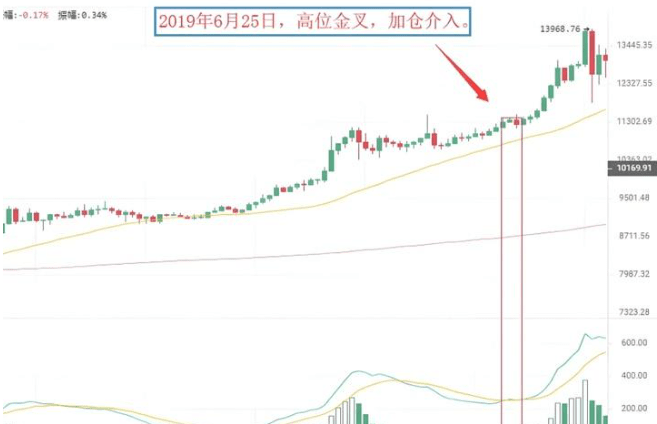
As shown above: On June 25, 2019, the BTC 3-hour candlestick chart shows that Bitcoin prices were in an upward trend and rose again after consolidation. At the same time, the MACD indicator formed a high golden cross. This indicates that the correction has ended and the price will resume the previous upward trend. Investors should pay attention to seize this buying opportunity to increase their positions. Situation 4: Selling point of low-level death crosses. Low-level death crosses refer to death crosses that occur far below the zero axis. This type of low-level death cross often occurs at the end of an upward rebound in a downtrend. Therefore, a low-level death cross is a sell signal that the rebound has ended. At this time, investors who are not in the market should wait and see. Investors who are still holding positions and are deeply trapped can sell first and buy back after the price drops to reduce costs.
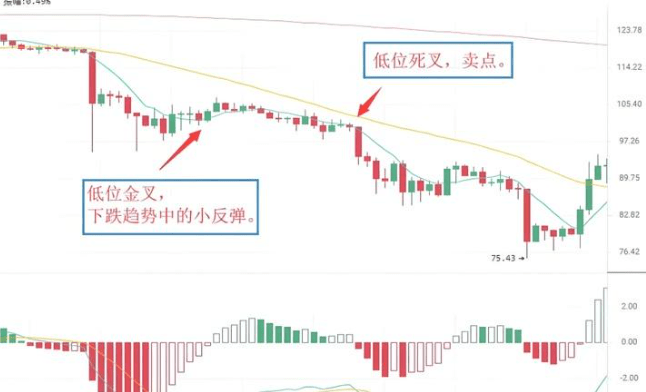
As shown in the figure above: On July 14, 2019, the LTC 3-hour candlestick chart showed a low-level golden cross in the MACD indicator of Litecoin. The price rebounded slightly, then quickly fell. Immediately afterwards, the MACD indicator formed a death cross below the zero axis, and the K-line began a new round of decline. Spot investors can sell positions at the death cross position and then cover them to reduce the cost of holding positions. Case 5: Selling point of the death cross near the zero axis. If the previous market direction has been a downward trend, the cross formed by the DIFF line falling below the DEA line near the zero axis is called a death cross near the zero axis. It indicates that the market has accumulated a lot of downward momentum near the zero axis. The appearance of the death cross indicates that the market's downward momentum has begun to be released, and the K-line will continue the original downward trend, which is a sell signal.
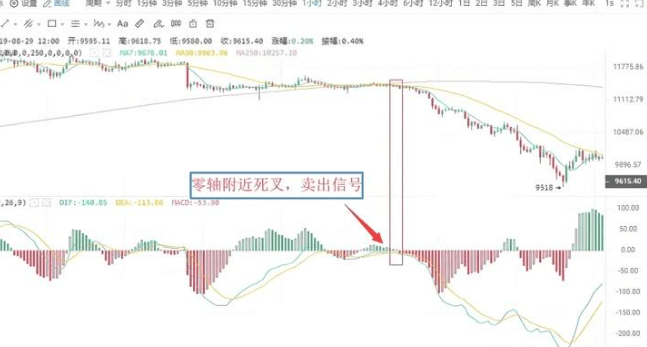
As shown above: On August 12, 2019, on the BTC 1-hour candlestick chart, Bitcoin's DIFF line crossed below the DEA line near the zero axis, forming a death cross. This indicates the beginning of downward market momentum and is a sell signal. Investors must decisively sell their positions, otherwise they will be deeply trapped. Case 6: Selling Point of a High-Level Death Cross A crossover formed when the DIFF line crosses below the DEA line well above the zero axis is called a high-level death cross. This type of death cross pattern is sometimes accompanied by a MACD top divergence. This manifests itself as: the price trend continues to hit new highs during a sustained upward movement, but the DIF and DEA lines of the MACD indicator no longer continue to rise or rise, but instead diverge from the price trend, gradually moving downward. Above the zero axis, the DIF line crosses below the DEA line, forming a downward crossover pattern. This is a death cross and a relatively reliable sell signal.
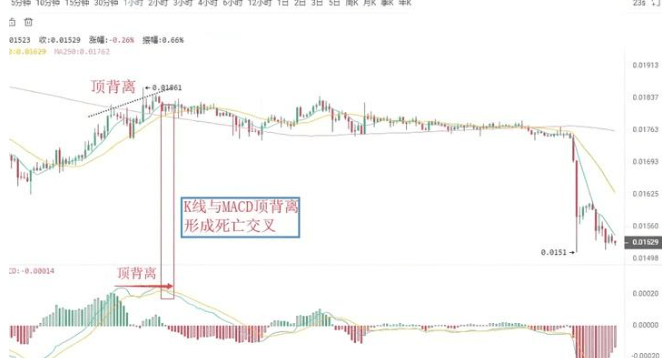
As shown in the figure above: On August 23, 2019, TRX 1-hour K-line chart, after the wave of Tron currency rose, the price continued to hit new highs, but the DIF line and DEA line no longer continued to rise, and then formed a death cross, a sell signal.
Divergence between MACD and K-line. Divergence is a term used in physics to describe momentum. In technical analysis, it is a highly successful and widely used analytical method. During a downtrend, when prices hit a new low but the indicator line does not, this is called a bottom divergence. This indicates that upward momentum is building and is a buy signal. During an uptrend, when prices hit a new high but the indicator line does not, this is called a top divergence. This indicates that downward momentum is building and is a sell signal.
Ⅰ. Bottom Divergence
(1) Bottom divergence between MACD bar and DIFF line The bottom divergence between DIFF line and price refers to the situation in which, during a downward trend, when the price hits a new low, the DIFF line does not hit a new low. It indicates that during the price decline, the decline of DIFF line is smaller than the decline of price, the upward momentum of the market is constantly accumulating, the price is about to stop falling, and the probability of rising in the next period of time is relatively high. The MACD bar is the MACD bar line hidden behind the DIFF line, which is divided into red and green. Its divergence with the price is an important use of the MACD indicator and is widely used in actual combat. The bottom divergence between MACD bar and price refers to the situation in which, when the price hits a new low wave after wave, the MACD bar does not hit a new low along with it. The upward momentum of the market is accumulating, the price is about to stop falling, and the probability of rising in the next period of time is relatively high. When bottom divergence occurs, investors can grasp the specific buying point in two ways.
(2) Specific buying opportunity The bottom divergence between the DIFF line, MACD bar and price is not a specific time point, but a pattern that appears over a period of time. However, when investors buy, it is a specific time point, indicating that the price is about to stop falling. Therefore, in order to grasp the specific buying opportunity, when the DIFF line, MACD bar and K line show a bottom divergence, investors must combine the bottom divergence with other technical analysis tools to concretize the buying point of the bottom divergence. First: The bar changes color or the golden cross of MACD The bar changes color, indicating that the market's upward momentum has begun to take the lead. It usually appears after the "bar shortening". Although it will be a while later, it is more reliable. When the bottom divergence appears, the bar changes color smoothly or forms a golden cross, and investors can buy.
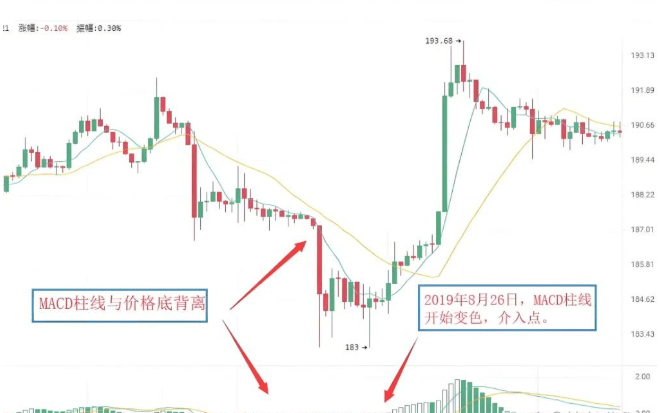
As shown in the figure above: On August 26, 2019, the 15-minute candlestick chart of Ethereum (ETH) showed that the price of Ethereum hit a new low during the decline, but the MACD bar line did not hit a new low, forming a bottom divergence pattern between the bar line and the price. It shows that the market's upward momentum has begun to accumulate, and there is a high possibility that the price will rise in the future. Immediately afterwards, the bar line changed color. The superposition of these two buy signals increased the reliability of the rising significance. Investors can intervene when the bar line changes color. Second: Combine with other technical analysis tools and K-line reversal patterns. Combining bottom divergence with K-line reversal patterns, such as the combination of "single needle bottoming" and "bottom red three soldiers", is the specific application of the "multi-indicator coordination" principle.
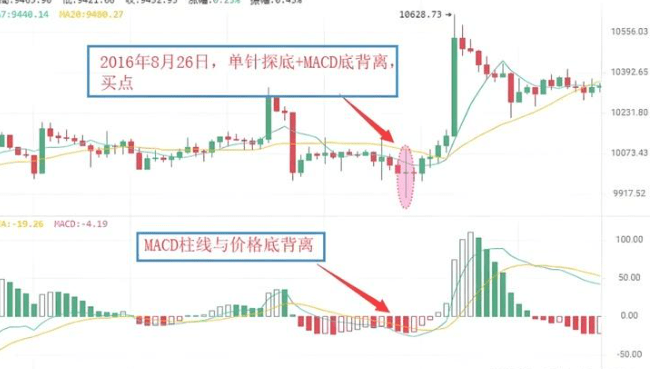
As shown above: On August 26, 2016, the BTC 30-minute candlestick chart showed Bitcoin prices hitting a new low, but the MACD-Histogram did not, forming a bottoming divergence between the bar chart and the price, indicating increasing upward momentum. As the price dipped, a buy signal emerged: a bottoming divergence between the MACD-Histogram and the price, and a single bottoming candlestick dip in the candlestick chart. Subsequently, the price began a wave of upward movement.
Ⅱ. Top Divergence
(1) Top Divergence between MACD-Histogram and DIFF Lines The top divergence between MACD-Histogram and K-line refers to the situation where, during an upward trend, the price hits a new high, but the MACD-Histogram does not. This indicates that downward momentum is accumulating in the market, and prices may fall at any time. The top divergence between DIFF line and K-line refers to the situation where, during an upward trend, the price hits a new high, but the DIFF line does not. This indicates that downward momentum is accumulating in the market, and prices are likely to fall next.
(2) Specific selling timing. Similar to bottom divergence, in actual operation, according to the principle of multi-indicator coordination, investors can combine the following methods to make the selling signal more specific. First: bar color change or MACD death cross. After the top divergence between the MACD bar and the K line is formed, once the bar suddenly shortens significantly, it indicates that the market's downward momentum has begun to release. Investors should pay attention to selling in time. The change of MACD bar color indicates that the market's downward momentum has taken the upper hand. It usually appears after the bar continues to shrink. If the bar changes color or the MACD death cross appears after the top divergence between the bar and the K line, investors should pay attention to exiting the market in time.
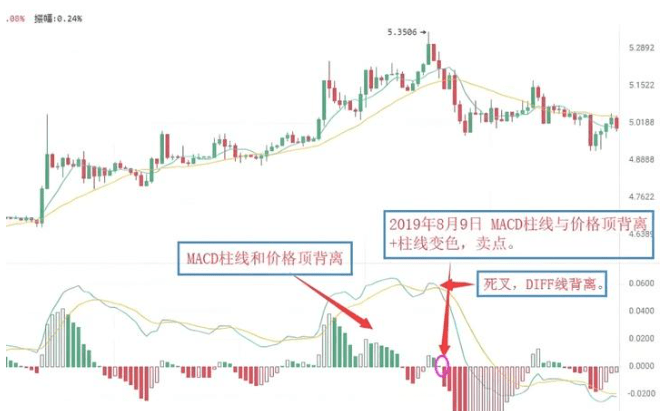
As shown in the figure above: On August 9, 2019, the HT1-hour K-line chart showed that the price of Huobi hit a new high, but the MACD bar line did not hit a new high, forming a top divergence pattern between the bar line and the price. It shows that the market's downward momentum has begun to accumulate, and the price may experience a downward trend at any time. Subsequently, the MACD bar line turned from red to green, issuing a sell signal of "top divergence between the bar line and the price + bar line color change". Investors should pay attention to exiting the market in time. Second: Combined with other technical analysis tools and K-line reversal patterns. After the MACD bar line and the price top divergence appear, if other technical analysis tools also show a sell signal at the same time, then the reliability of the market's selling significance will be greatly increased. At this time, investors should pay attention to exiting the market decisively. Common sell signals of this type include "top divergence between the bar line and the price + K-line reversal pattern".
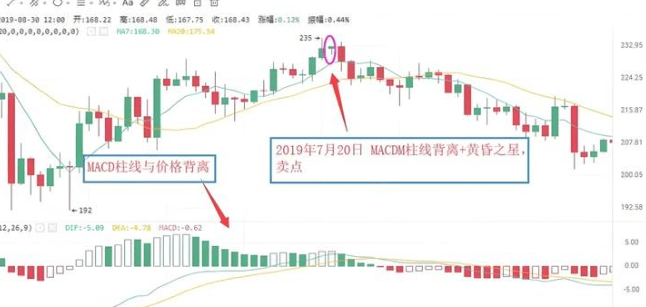
As shown above: On July 20, 2019, the ETH 3-hour candlestick chart showed Ethereum's price reaching a new high, but the MACD-Histogram did not, forming a top divergence between the candlestick and the price. This indicates that downward market momentum is increasing and a wave of price decline is possible. Subsequently, the MACD-Histogram gradually shortened, and the candlestick formed a bearish Evening Star pattern. Investors should be careful to exit the market promptly, as the candlestick subsequently experienced a significant downward trend. Note: Evening Star: During an upward candlestick pattern, a long bullish candlestick appears first, followed by a shorter candlestick (either bullish or bearish) the next day. People liken it to a star, forming the main part of the candlestick pattern. The third candlestick is a long bearish candlestick that penetrates the main body of the first candlestick. Evening Star signals a price peak and a subsequent decline, with some predictions boasting an accuracy rate exceeding 80%. (Regarding some K-line patterns that indicate peaks and bottoms. We will have several dedicated courses covering this in depth later, so please stay tuned.) Modifying MACD Parameters: A flaw of the MACD indicator is that it reacts to price changes with a lag, sometimes resulting in suboptimal buy and sell prices. One way to address this is to adjust the indicator parameters to make them more sensitive to market trends, thereby optimizing buy and sell prices. In commonly used market software, the default parameters for the MACD indicator are 12/26/9. With these parameters, the MACD indicator often reacts to price changes with a significant lag. This lag can be addressed by adjusting the parameters. Common parameter combinations include 5/34/5 and 5/10/30. Investors can experiment and explore more in practice.
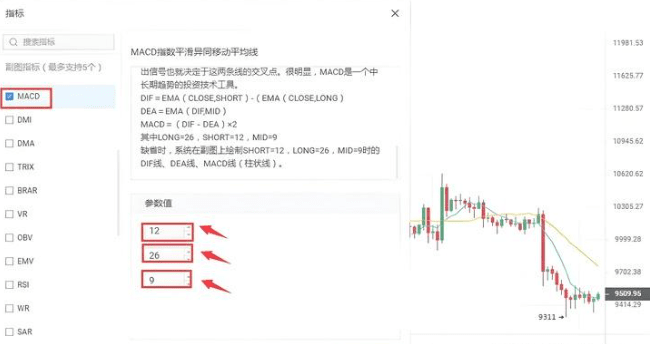
Execution is the key flaw in trading, and holding onto positions is a common problem in investing. Without good execution, even the best strategies can't be realized. However, with excessive holding, even the smallest mistakes are magnified, multiplying like a disease. When you can no longer bear it and leave the market, I doubt anyone will say goodbye. Even if you were there, no one will remember you a year from now. Never rely on luck to hold onto a position, and never bet with a full position on any gamble. One misstep and you're done. Success is achieved only when you succeed a hundred times.

[Coin Circle] 10 profound conclusions from my own investment
1. After I studied many books on stock K-line and economics,
I found that psychology is more suitable for practical application in the cryptocurrency circle.
2. There has always been a phenomenon in the cryptocurrency circle: the last one standing is the winner.
As long as you keep playing and never give up, you will have a chance to turn things around in the end.
When you think you are unlucky and sell your inventory, the imaginary loss becomes a real loss.
3. Don’t participate in high-risk markets with money you can’t afford to gamble.
Don't try to participate in the speculative market when you don't have the ability to speculate.
Speculation is to listen to stories told by individuals, then participate in them, and then withdraw before the public sees through them.
4. Learn to understand not to easily accept other people’s opinions.
You should first think independently before starting your own investment behavior. After all, the money is in your own hands.
5. Don’t touch futures, human nature cannot stand the test.
Under the high-pressure emotions of futures trading, it is extremely difficult to achieve unity of knowledge and action, so even if there is a 51% winning rate or even a 65% winning rate, you should not touch it.
If you encounter a predictable one-sided market, you should also apply the Kelly formula to avoid losing all your capital under irrational circumstances and making it difficult to recover. See the second point.
6. Study hard and invest in yourself.
Reading is a form of spiritual practice and can indeed improve one's quality of life.
Improving one's cultivation is more important than money.
When it comes to investing in yourself, money is merely a basic necessity. It doesn't mean you're investing in yourself just by spending money, nor does it mean you'll become more successful just by buying books or getting a credit card. What's more important is self-control and thinking ability. Without self-control, you're wasting money, and without thinking ability, you're just speculating. Honestly, if you don't have confidence in your self-control, forget about investing in yourself. First, practice how to persevere and do well in one thing.
For example: insist on fixed investment
For example: learning to identify valid information.
7. Recommended investment books
Cash flow: (Rich Dad Poor Dad) (Puppy Money)
Human nature: (human weaknesses) (the mob) and game
Blockchain: (Illustrated Blockchain) (Simple and easy to understand)
(Bitcoin) White Paper (English Version)
8. Understand the significance of investment
When investing in the future, you need to understand the significance of spending money here and in the future.
Moreover, the essence of buying an investment product is to buy an opportunity, and the essence of selling an investment product is to sell a risk. If you have a chance, then buy; if you have a risk, then sell. You will not make false profits or losses due to price fluctuations.
9. Have a passive income mindset.
Someone who earns 20,000 RMB a month loses 29 days of freedom in a month.
With a monthly income of 2000, all of it is passive income.
The younger you are, the more you should lean towards the latter.
Speculating in the cryptocurrency world means losing your freedom.
Investing in the cryptocurrency world is about gaining freedom.
10. Disagreement and doubt will be the ultimate driving force behind the start of a bull market
Exchanging time for space and people no longer wanting to get on board will be the beginning of a bull market.
Always be curious about new things, and don’t miss the next hype story because of being stuck in the past.
BTH BCT PEPE

